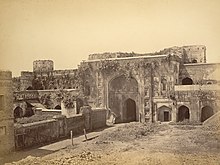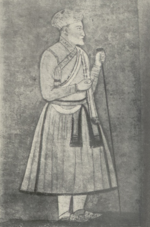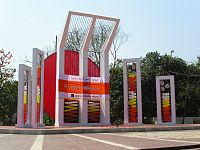History of Dhaka: Difference between revisions
Dead.rabbit (talk | contribs) added photos |
Dead.rabbit (talk | contribs) added info with reference |
||
| Line 22: | Line 22: | ||
In 1412 CE Shah Ali Baghdadi, a saint arrived in [[Delhi]] and then came to Dhaka where he became a disciple of Shah Bahar of the Chistia order.<ref name=bpediabaghdadi>Mosharraf Hussain Bhuiyan, [http://www.banglapedia.org/httpdocs/HT/S_0233.HTM Shah Ali Baghdadi (R)], [[Banglapedia]]: The National Encyclopedia of Bangladesh, [[Asiatic Society]] of Bangladesh, [[Dhaka]], ''Retrieved: 2012-08-21''</ref> His tomb is still at [[Mirpur Thana|Mirpur]] on the outskirts of Dhaka. |
In 1412 CE Shah Ali Baghdadi, a saint arrived in [[Delhi]] and then came to Dhaka where he became a disciple of Shah Bahar of the Chistia order.<ref name=bpediabaghdadi>Mosharraf Hussain Bhuiyan, [http://www.banglapedia.org/httpdocs/HT/S_0233.HTM Shah Ali Baghdadi (R)], [[Banglapedia]]: The National Encyclopedia of Bangladesh, [[Asiatic Society]] of Bangladesh, [[Dhaka]], ''Retrieved: 2012-08-21''</ref> His tomb is still at [[Mirpur Thana|Mirpur]] on the outskirts of Dhaka. |
||
[[Binat Bibi Mosque]] was built in 1454 at Narinda area of Dhaka during the reign of the Sultan of Bengal, [[Mahmud Shah (Sultan of Bengal)|Nasiruddin Mahmud Shah]] (r. 1435–1459).<ref>{{cite web |
|||
|url=http://archnet.org/library/sites/one-site.tcl?site_id=7368 |
|||
|title=Binat Bibi Mosque |
|||
|publisher=ArchNet Digital Library |
|||
|accessdate=2012-09-18 |
|||
}}</ref> It is the oldest brick structure that still exists in the city.<ref>[http://www.thedailystar.net/forum/2008/august/jahangirnagar.htm ''From Jahangirnagar to Dhaka'' by Faruque Hasan in ''The Daily Star'']</ref> |
|||
==Mughal rule== |
==Mughal rule== |
||
[[Image:1814 Lalbagh Fort paiting by DOyly.jpg|right|thumb|1814 painting of [[Lalbagh Fort]] by Charles D'Oyly showing the South wall, beside the [[Buriganga River]].]] |
[[Image:1814 Lalbagh Fort paiting by DOyly.jpg|right|thumb|1814 painting of [[Lalbagh Fort]] by Charles D'Oyly showing the South wall, beside the [[Buriganga River]].]] |
||
Revision as of 07:35, 18 September 2012

The history of Dhaka begins with the existence of urbanised settlements in the area that is now Dhaka dating from the 7th century CE. The city area was ruled by the Buddhist kingdom of Kamarupa before passing to the control of the Sena dynasty in the 9th century CE.[2] The Dhaka area of that time was identified as Bangala. After the Sena dynasty, Dhaka was successively ruled by the Turkish and Afghan governors descending from the Delhi Sultanate before the arrival of the Mughals in 1608. After Mughals, British ruled the region for around 200 years until the independence of Pakistan in 1947. Dhaka became the capital of the East Pakistan province. Since the independence of Bangladesh from West Pakistan in 1971, Dhaka has been the capital of Bangladesh.
Etymology

There are several theories on the origin of the name Dhaka. Some believe that the name came following the establishment of Dhakeshwari temple by Raja Ballal Sena in the 12th century CE and Dhakeswari is the name of a Goddess. Some argue that the Dhak (a membranophone instrument) is used as part of the Durga Puja festival in this temple and hence the name Dhaka. While others say that Dhakeshwari stands the meaning of Goddess of Dhaka; so the temple must have been named after the region.
Buddhist/Hindu Kingdom
Dhaka area was under Pala Empire from 8th century until late 11th century. Vikrampur, a region nearby Dhaka, was their capital. Nothing much is known about Dhaka around that time. Since Sena dynasty started ruling the region in 1095 CE, largely Hindu community populated the lower Dhaka region. Localities like Laksmibazar, Banglabazar, Sutrapur, Jaluanagar, Banianagar, Goalnagar, Tantibazar, Shankharibazar, Sutarnagar, Kamarnagar, Patuatuli and Kumartuli are the examples of settlements of Hindu craftsmen and professionals.[3] According to popular legend, Dhakeshwari Temple was built by Ballal Sena, the second Sena ruler.[4] Another tradition says, there were fifty two bazaars and fifty three streets and the region acquired the name of Baunno Bazaar and Teppun Gulli.[5]
Sultanate Period
Upon arrival of Islam in this region, Turkish and Afghan rulers reigned the area from early 14th century until late 16th century. An Afghan fort (also known as Old Fort of Dhaka) was built at that time which was later converted to the present-form of Dhaka Central Jail in 1820 by the British.[6] A 17th century historian, Mirza Nathan, described the fort in his book Baharistan-i-Ghaibi as "surrounded by mud walls and the largest and strongest in pre-Mughal era".[6]
In 1412 CE Shah Ali Baghdadi, a saint arrived in Delhi and then came to Dhaka where he became a disciple of Shah Bahar of the Chistia order.[7] His tomb is still at Mirpur on the outskirts of Dhaka.
Binat Bibi Mosque was built in 1454 at Narinda area of Dhaka during the reign of the Sultan of Bengal, Nasiruddin Mahmud Shah (r. 1435–1459).[8] It is the oldest brick structure that still exists in the city.[9]
Mughal rule


Around 1550 a Portuguese historian, João de Barros, first inserted Dhaka into the map in his book Décadas da Ásia (Decades of Asia).[3]
During the reign of Emperor Akbar (r. 1556–1605), Dhaka was referred as a Thana (a military outpost).[10] Dhaka was situated in Bhati region which hosted several rebel forces led by Bara-Bhuiyans from mid to late 16th century. After the leader of Bara-Bhuiyans, Musa Khan, was subdued by Mughal General Islam Khan Chisti in 1610, Dhaka went directly under control of Mughals. Being newly appointed Governor of Bengal, Islam Khan transferred the Bengal capital from Rajmahal to Dhaka in order to crush further rebel uprisings.[3] He also renamed Dhaka as Jahangirnagar (City of Jahangir); Jahangir was the Mughal Emperor at that time. Due to its location right beside some main river routes, Dhaka was an important center for business. The Muslin fabric was produced and traded in this area.
As the next governor, Prince Shuja built Bara Katra between 1644 and 1646 in Dhaka to serve as his official residence. In late 1640s, for personal and political reasons, he shifted the capital back to Rajmahal. Dhaka became a subordinate station. Due to political turmoil, Emperor Aurangzeb sent Mir Jumla to deal with Prince Shuja.[11] He pursued Shuja upto Dhaka and reached the city on 9 May 1660. But Shuja fled to Arakan region. Jumla was ordered to become the next Governor of Bengal. Dhaka was again made the headquarter of the region. Construction of Lalbagh Fort was commenced in 1678 CE by Prince Muhammad Azam during his 15-month long vice-royalty of Bengal, but before the work could complete, he was recalled by Emperor Aurangzeb.

The largest expansion of the city took place under the next Mughal governor Shaista Khan (1664–1688). The city then stretched for 12 miles in length and 8 miles in breadth and is believed to have had a population of nearly a million people.[12] The Chawk Mosque, Babubazar Mosque, Sat Gumbad Mosque, Choto Katra were originally built during this period. He also built tombs of Bibi Pari, Bibi Champa and Dara Begum.[3] A French traveller, Jean-Baptiste Tavernier, arrived Dhaka on 13 January, 1666 and met Shaista Khan.[13] He referred Shaista Khan as "the uncle of King Aurangzeb and the cleverest man in all his kingdom".[13]
Prince Azim-ush-Shan became the Governor of Bengal in 1697. Due to conflict with Diwan Murshid Quli Khan, he shifted his office from Dhaka to Patna in 1703.[14][15] Murshid Khan also shifted his office to Mauksusabad (later renamed it to Murshidabad).
Nawab era
In 1716 Murshid Quli Khan was made the Governor of whole Bengal. He became so powerful that he acted as the de-facto independent ruler of the region. The era continued through Shujauddin Khan (1729–1739), Sarfaraz Khan (1739–1740), Alivardi Khan (1740–1756) and Sirajuddaula (1756–1757). They were unofficially known as Nawabs.[16] They ruled the whole region from their offices in Murshidabad.
Naib-Nazim of Dhaka
The position of Naib-Nazim (Deputy Governor) was created to administer Dhaka Niabat since 1717.[16] They were appointed by the Governors until Siraj ud-Daulah, the last independent Governor of Bengal, lost control to the British in the Battle of Plassey in 1757. Here is a partial list of Naib-Nazims of Dhaka[15]:
- Khan Muhammad Ali Khan (1717)
- Itisam Khan (1723–1726)
- A son of Itisam Khan (1726–1727)
- Mirza Lutfullah (a grandson-in-law of Murshid Quli Khan) (1728–1733)
- Jasarat Khan (1756–1762 and again 1765–1778).
- Ghaziuddin Haider (1834–1843).
The office of Naib Nazim of Dhaka was officially abolished in 1843.[16]
Armenian settlements
The Armenians settled in Dhaka in early 18th century.[17] They established successful trade ties in jute and leather with Mughals and Nawabs.[18] The Armenian Church built in 1781 in Armanitola area bears the evidence of their presence. Since the British started ruling Bengal in 1757, Armenians slowly moved out of this area. As of 2003 CE, Michael Joseph Martin was the last Armenian living in Dhaka.[19]
British rule

The English formally established their factories in Dhaka in 1668.[13] The English agents were already in the city as early as in 1666 when Tavernier visited.[13] William Hedges was appointed the first governor of British East India Company. He arrived Dhaka on 25 October, 1681.[20] The city passed to the control of the Company in 1765 after the Battle of Plassey. The city then became known by its anglicized name, Dacca. Owing to the war, the city's population shrank dramatically in a short period of time.[21] Although an important city in the Bengal province, Dhaka remained smaller than Kolkata, which served as the capital of British India for a long period of time. Under British rule, many modern educational institutions, public works and townships were developed. A modern water supply system was introduced in 1874 and electricity supply in 1878.[22] The Dhaka Cantonment was established near the city, serving as a base for the soldiers of the British Indian Army. Dhaka served as a strategic link to the frontier of the northeastern states of Tripura and Assam.
Charles D'Oyly was the Collector of Dhaka from 1808 to 1811. He made a good collection of painting folios of Dhaka in Antiquities of Dacca.[23] These paintings exhibited much of the ruins of Dhaka from the Mughal era. A short historical account of the paintings was also appended to each book. James Atkinson wrote these accounts, accompanied by engravings done by Landseer.
Dacca Municipality (later Dhaka City Corporation) was established on August 1, 1864.[24]
In July 1905 Lord Curzon, Viceroy of India, decided to take effect the Partition of Bengal. Dhaka became the capital of the new province, Eastern Bengal and Assam. But the decision was revoked in 1911.
East Bengal/Pakistan's capital
Following the partition of Bengal in 1905 and again in 1946, Dhaka became the capital of East Bengal. On August 15, 1947 East Bengal became a part of the new Muslim state of Pakistan. The city witnessed serious communal violence that left thousands of people dead. A large proportion of the city's Hindu population departed for India, while the city received hundreds of thousands of Muslim immigrants from the Indian states of West Bengal, Assam and Bihar. The city's population catapulted in a very short period of time, creating severe shortages and infrastructural problems.[25] As the centre of regional politics, Dhaka saw an increasing number of political strikes and incidents of violence. The proposal to adopt Urdu as the sole official language of Pakistan led to protest marches and strikes involving hundreds of thousands of people in BengaliLanguage Movement. The protests soon degenerated into widespread violence after police firing killed students who were demonstrating peacefully. Martial law was be imposed throughout the city for a long period of time.

The arrest of the Bengali politician (later to become known as the father of the nation) Sheikh Mujibur Rahman in 1968 would also spark intensive political protests and violence against the military regime of Ayub Khan. The 1970 Bhola cyclone devastated much of the region, killing numerous people. More than half the city of Dhaka was flooded and waterlogged, with millions of people marooned. The following year saw Sheikh Mujib hold a massive nationalist gathering on March 7, 1971 at the Race Course Ground that attracted an estimated one million people. Galvanising public anger against ethnic and regional discrimination and poor cyclone relief efforts from the central government, the gathering preceded the March 26 declaration of Bangladesh's independence. In response, the Pakistan Army launched Operation Searchlight, which led to the arrests, torture and killing of hundreds of thousands of people, mainly Hindus and Bengali intellectuals. The fall of the city to the Indian Army on December 16 marked the creation of the independent state of Bangladesh.
Post-independence
Despite independence, political turmoil continued to plague the people of Dhaka. The Pakistan Army's operations had killed or displaced millions of people, and the new state struggled to cope with the humanitarian challenges. The year 1975 saw the killing of Sheikh Mujib and three military coups. The city would see the restoration of order under military rule, but political disorder would heighten in the mid-1980s with the pro-democracy movement led by the Awami League and the Bangladesh Nationalist Party. Political and student strikes and protests routinely disrupted the lives of Dhaka's people. However, the post-independence period has also seen a massive growth of the population, attracting migrant workers from rural areas across Bangladesh. A real estate boom has followed the development of new settlements such as Gulshan, Banani and Motijheel. In 1985, Dhaka hosted the inaugural summit of the South Asian Association for Regional Cooperation. It has also hosted the summits of the D8 group and the Organisation of the Islamic Conference.
References
- ^ The city of Dacca viewed painting by De Fabeck Frederick
- ^ "History" (PHP). 2006-09-05. Retrieved 2006-09-05.
{{cite web}}:|first=missing|last=(help) [dead link] - ^ a b c d AM Chowdhury, Dhaka, Banglapedia: The National Encyclopedia of Bangladesh, Asiatic Society of Bangladesh, Dhaka, Retrieved: 2012-08-18
- ^ M Muktadir Arif Mozammel, Dhakeshwari Temple, Banglapedia: The National Encyclopedia of Bangladesh, Asiatic Society of Bangladesh, Dhaka, Retrieved: 2012-08-24
- ^ [The Romance of an Eastern Capital by F. B. Bradley-Birt (1906), page 94
- ^ a b An Architect's Dhaka - Daily Star
- ^ Mosharraf Hussain Bhuiyan, Shah Ali Baghdadi (R), Banglapedia: The National Encyclopedia of Bangladesh, Asiatic Society of Bangladesh, Dhaka, Retrieved: 2012-08-21
- ^ "Binat Bibi Mosque". ArchNet Digital Library. Retrieved 2012-09-18.
- ^ From Jahangirnagar to Dhaka by Faruque Hasan in The Daily Star
- ^ Akbarnama
- ^ Abdul Karim, Mir Jumla, Banglapedia: The National Encyclopedia of Bangladesh, Asiatic Society of Bangladesh, Dhaka, Retrieved: 2012-08-18
- ^ Dhaka Under the Mughals - Dhaka South City Corporation
- ^ a b c d [The Romance of an Eastern Capital by F. B. Bradley-Birt (1906), page 144
- ^ Diwans were separate positions for financial and revenue administration and they were directly appointed by the Emperor.
- ^ a b KM Karim, Naib Nazim, Banglapedia: The National Encyclopedia of Bangladesh, Asiatic Society of Bangladesh, Dhaka, Retrieved: 2012-08-20
- ^ a b c Sirajul Islam, Nawab, Banglapedia: The National Encyclopedia of Bangladesh, Asiatic Society of Bangladesh, Dhaka, Retrieved: 2012-08-19
- ^ Sushil Chaudhury, The Armenians, Banglapedia: The National Encyclopedia of Bangladesh, Asiatic Society of Bangladesh, Dhaka, Retrieved: 2012-09-06
- ^ The Armenian Church: Legacy of a Bygone Era by theindependent
- ^ The mission of Dhaka's last Armenian by BBC
- ^ [The Romance of an Eastern Capital by F. B. Bradley-Birt (1906), page 156
- ^ "History" (PHP). 2006-09-05. Retrieved 2006-09-05.
{{cite web}}:|first=missing|last=(help) [dead link] - ^ {B}
[Kamrul Hasan], Dhaka City Corporation (2006-09-05). "History" (PHP). Retrieved 2006-09-05.
{{cite web}}: line feed character in|last=at position 4 (help) [dead link] - ^ Muntassir Mamoon, Antiquities of Dacca by Charles D'Oyley, Banglapedia: The National Encyclopedia of Bangladesh, Asiatic Society of Bangladesh, Dhaka, Retrieved: 2012-08-22
- ^ "Don't split Dhaka, Khoka urges govt". UNBConnect. 12 November 2011. Retrieved 12 Sep 2012.
- ^ "History" (PHP). 2006-09-05. Retrieved 2006-09-05.
{{cite web}}:|first=missing|last=(help) [dead link]
